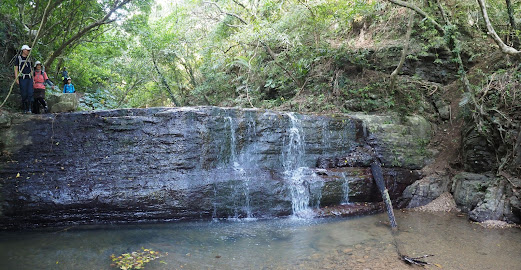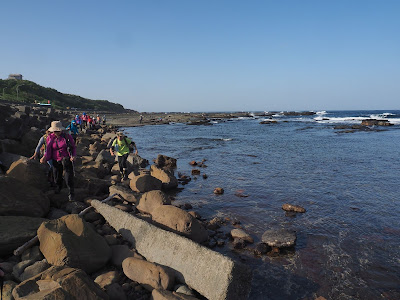 |
| North peak of Mt. Bijia-shan seen from the south peak |
筆架山連峰は、台北近くの山のなかではその稜線が程よく長く、またいくつもの小ピークや岩場があるので、人気の登山対象である。貓空側からでも石碇側からでも、数時間で歩くことができる。休日ともなれば、多くのハイカーが稜線縦走路を行く。稜線の途中から、北側深坑あるいは南側烏塗窟へと通じる道もある。これら連峰縦走路の途中でつながる山道は、実はあまり歩かれていない。そのため、久しく歩かれていないと草に埋もれる。筆者は、
十年ほど前今回のルートとほぼ同じルートを烏塗窟側から筆架山に登り、深坑側へと降りた。その時は、かなり草深かったことを覚えている。今回は、ボランティアグループによって、これらの道の手入れがされた機会に、逆方向に歩いた。
 |
| @ Mt. Bijia-shan saddle between two peaks (Mr. Wang's photo) |
------------------------------
 |
| Hiking from west to east |
Mt, Bijia-shan (筆架山, elevation 585 meters) and its adjacent peaks compose a range of mountains that stands south of Shenkeng (深坑). Its proximate location to urban Taipei makes this range a popular destination of hiking. Its exposed rocks on summits and along the trekking route are another attraction besides its closeness to Taipei. You would meet a lot of hikers when you go there on weekends.
 |
| Shanyangdong cave (山羊洞) |
The trekking route across the entire range is a good trail with proper maintenance. On the other hand, there are several paths connecting peaks and their foot, but they are not so much traveled as the ridge route, which means you would come across weed-choked sections.
I travelled such trail about 10 years ago and had to go through weeds. Volunteers came in and cleared trails in this mountain region a couples of months ago. So a few friends and I went there and found the trails in good shape, which made our hiking very enjoyable.
----------------------------
 |
| Brown 15 line bus at Caonan |
We meet at MRT Taipei Zoo station (捷運動物園站) around 7:00, from which two lines of buses go to our destination Caona (草湳). Seven friends and myself take a Brown 15 (棕15) line bus at 7:24. When we get to Caonan at 7:50, another two friends are there waiting for us to join.
 |
| Large banyan tree and our members |
 |
| Going further up to the trail head |
 |
| At the trail head |
We take a road splitting right from the bus road and go up. About 10-miutes ascent brings us to a open space where a large banyan tree (榕樹) stands by the road. This is also a junction and we take left one to go further up. We already run into several hikers on our way, which shows how popular this mountain area is. At 8:17 we hit our trail head.
 |
| Trail with stone steps |
 |
| Arriving at the top of trail |
 |
| Resting at the junction for Bijia-shan |
This trail leads up to the ridge connecting Mt. Erge-shan (二格山) and Mt. Houshanyue (猴山岳). On our way up, we pass two junctions. There are many paths crisscrossing beneath the ridge line. At 8:43 we reach the top of trail where a trail running along the ridge line meets. We take right and go further up for a few minutes to another junction where a path to Mt. Erge-shan and one to Mt. Bijia-shan split. We have a short break there.
 |
| Heading for Bijian-shan, a shinny bridge ahead |
 |
| Many ups and downs along the way |
This very location was once called "Green been soup junction (綠豆湯鞍)" because a temporary week-end-only shop sold soup to hikers many years ago. I encountered the legendary shop once several years ago, but apparently it is no longer coming up here. After a short break we head for Mt. Bijia-shan. The trail soon passes a stainless steel bridge alongside the cliff and keeps on atop the ridge, which bare rocks show up one after another. This is one of characteristics of Mt. Bijia-shan trekking route. In a few minutes we pass by a big bare rock which you can go up to its top to see a nice view.
 |
| A large bare rock by the trail |
 |
| Panoramic view from the top of rock |
 |
| More ups and downs to go over |
Today's weather is pretty nice and the air is clear so we can see Yangmingshan (陽明山) mountain range over another lower mountain range in front and the town of Shenkeng (深坑) in the valley below. The whole urban area is also visible beyond Mt. Houshanyue. We follow the ridge trail passing over many humps to reach a long stepped path just below Mt. Jijia-shan at 9:45. The steps are chiseled out on the side of a large rock. The top of the stepped path is a gap between the twin peaks of Bijia-shan. The name of mountain, Bijia, means a brush rest, because the two peaks stand side by side and from distance they look like two humps of a brush rest with a dip in between.
 |
| Chiseled steps beneath Bijia-shan |
 |
| Gap between the twin peaks |
 |
| Going down along a steep section |
We have a long rest here while most of our members go up to each peak. There are two trails coming up to Mt. Bijia-shan from its foot, one each from north and south side. At 10:15 we take one going down to the south side, which I came up along ten years ago. The track was covered with grasses at that time. It was only a month or so ago that volunteers cleared the track, so now it is wide and clean and ropes are fixed at many spots.
 |
| Keep going down |
 |
| Stone piled foundation |
The upper part of this trail is steep and it gets gentle as we go down in the valley. We pass a large stone-pilled foundation of a house where no house stands now and a Tudigong (土地公) shrine near the end of the trail. We come out onto a paved road at 11:03. We take left of it and go down to a red house with a barking dog. The paved road ends by the house and a dirt trail continues. The flat trail goes along a narrow valley and leads to Shengjia Shanzhuang (聖家山莊, Holly house), which we reach at 11:18. We have a lunch break under the roof of the house. It is yet very warm at this time of a day and we appreciate shade under the roof.
 |
| Tudigong shrine |
 |
| Walking down to red house |
 |
| Passing by an unattended orchard with many fruits fallen on ground |
 |
| Shengjia Shanzhuang (聖家山莊) |
 |
| A statue of Maria by the trail |
At 11:55 we start for Shangyangdong cave (山羊洞, elevation 362m) by a trail that goes up just by the Shengjia Shanzhuang. It passes a statute of Maria and keeps on a steep ascent. About 10 minutes ascent brings us onto a summit of the trail, where a another trail splits to Shanyangdong. We take right to go on this ridge trail and up to the highest point. Passing a group of several hikers we go down to the cave.
 |
| Going up a steep slope |
 |
| Top of the trail |
 |
| Passing by a group of hikers resting |
 |
| Author squeezing out of the cave |
The cave is a hole in the large rock that goes through to the other end. Shangyang, literal translation is mountain goats, are in fact not a goat but belongs to the bovidae group and live in higher mountains, not in such lower mountains.We pass through the cave to the other end and further down to another cave called Xiaoyaodong cave (逍遙洞), which we reach at 12:30. Several members go up to it. We the climb back to Shangyangdong and further up to the junction where we came up from Shengjia Shanzhuang a while ago. We go down the other side of the trail, which soon joins a paved road. At the trail head we have some rest before the final leg of our hike at 13:08.
 |
| Going further down to Xiaoyaodong cave |
 |
| Xiaoyaodong cave |
 |
| Shanyangdong cave trail head |
 |
| Trail starts by the local house |
One of our members leave us here to a nearby bus stop Wutuke (烏塗窟). The rest of us continue our hike at 13:32 for Mt. Xibianliao-shan (溪邊寮山, elevation 411m). We go up a little along the paved road to a house where our trail starts at its side. A short 10-minute climb brings us to the top of the trail. This is a four-way junction on the ridge, to the left (north) back for Bijian-shan mountain range and to the right for Mt. Xibianliao-shan.
 |
| Four-way junction on the ridge |
 |
| Summit of Xibianliao-shan |
We take the right trail and going up along the ridge. After climbing a steep slope we reach our final peak of the day, Xibiaoliao-shan at 13:52. After taking a short rest at the peak we go down along the ridge to a junction. The ridge trail keeps on along the ridge but we take left at the junction and go steeply down into the valley. We join Moruxiang ancient trail (摸乳巷古道) in the valley bottom at 14:31. Moruxiang means touching breast alley, so narrow a path that you almost touch a wall when passing. There is no such narrow passage along the trail, but it comes from the local name of the place.
 |
| Junction for Moruxiang trail (left path) |
 |
| Going down to the valley bottom |
 |
| Ruin of an abandoned house |
 |
| Going down along the old trail |
Soon after we meet the trail a large abandoned house shows up. Their roofs are all gone, but the stone walls are still intact. The trail goes along a stream and branches a trail to left to Bijianshan mountain range on the way. by which we pass at 14:50. We walk for several more minutes to come to the trail end. As I check the bus schedule, it shows that a # 666 bus from Wutuke will pass nearby stop soon so we hurry along the paved road for it. We reach Linshizhan (臨時站) bus stop at 15:10. In a few minutes a bus comes along.
 |
| Junction |
 |
| Trail end |
 |
| #666 bus has come along |
------------------------
 |
| Weed covered trail 10 years ago |
On a very fine autumn day we had a wonderful hike. The trail was all in good shape thanks to the efforts of volunteers. I assume that the Bijian-shan main ridge route and Shangyangdong trail remain good because they are maintained and very often travelled. The other trails of our hike this time would, on the other hand, not be in good condition after a year or so. The nature claims back its original state and the tracks would be covered with weeds again. Go and enjoy while they are still good.












































































































